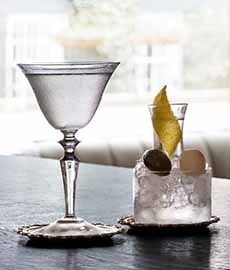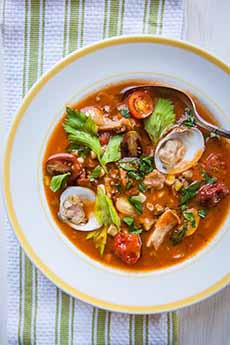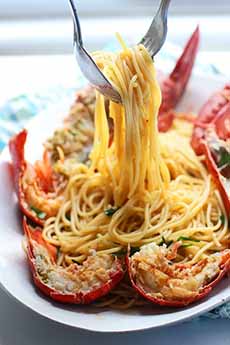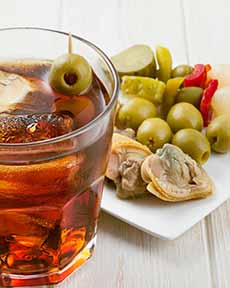TIP OF THE DAY: Uses For Vermouth
|
|
June 19th is National Dry Martini Day. Both the original, with gin, and the modern, with vodka, have a second ingredient in common: dry vermouth. Vermouth is an aromatized white wine, fortified with distilled alcohol and infused with various botanicals (barks, flowers, herbs, roots, seeds, spices) chosen by the producer. Fortifying with a base spirit allows the opened bottle of wine to stay fresher, for longer (keep it in the fridge). Even so, vermouth, though fortified, is still a wine and not a liquor. It has a shelf life. If refrigerated properly, it should keep anywhere from four to six weeks after opening. Serve it instead of wine: chilled or over ice with a lemon peel. Or, use it to cook, as illustrated below. Here’s the history of vermouth, which evolved from a use by apothecaries in Northern Italy and Germany, in the 16th century. To make bitter medicines more palatable, apothecaries would blend extracts of herbs and roots with wine and brandy*. Later, in the Italian city of Turin, vermouth became an apéritif, served at fashionable cafés. Two types of vermouth evolved—dry/white and sweet/red—with subsequent additional styles including extra-dry white, sweet white (blanc or bianco), red, amber (ambre), and rosé. In the late 19th century, dry vermouth became popular with bartenders as a key ingredient in cocktails that are still popular today: the Manhattan, the Martini/Gibson†, the Rob Roy, and the Negroni, among others. Sweet vermouth is typically served as a spritzer, with a bit of simple syrup and fresh lemon, lots of club soda, and a mint garnish. But you can also cook with vermouth. > March 21st is World Vermouth Day. > Vermouth Spritz cocktail recipe. Dry Vermouth In addition to being consumed as an apéritif or cocktail ingredient, dry vermouth can be substituted for white wine in cooking. Vermouth is fortified so is a bit stronger; you can use less if you’re concerned about too much wine flavor. Also be sure that the dish you’re making can stand up to the light flavors of the botanicals. If you open a bottle for cocktails, continue to use it in your recipes to: Not surprisingly, sweet vermouth works better than dry vermouth in sweet recipes. You can use it in place of other fortified red wines, such as Madeira, marsala, port, and sherry.
*Virtually all spirits—liquors and liqueurs—were first developed for medicinal purposes. †A Gibson is a Gin Martini served with cocktail onions instead of olives. |
|
|
CHECK OUT WHAT’S HAPPENING ON OUR HOME PAGE, THENIBBLE.COM. |
||







